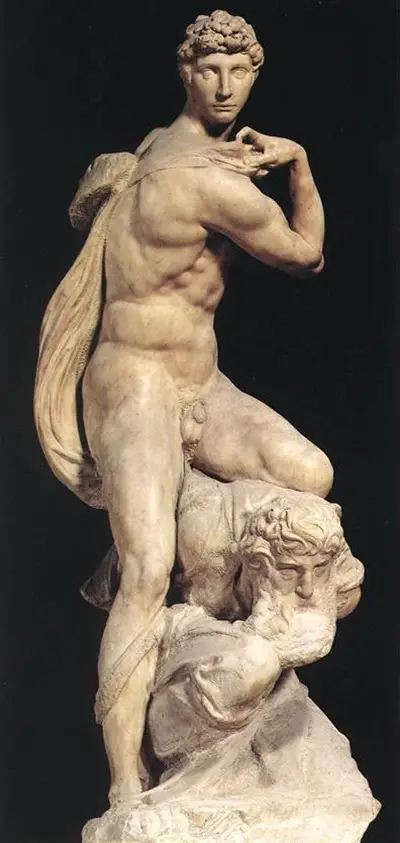The statue made from marble stands at an impressive 261 centimetres(103 inches). Today, The Genius of Victory, is housed in the Palazzo Vecchio in Florence, Italy. The marble statue was commissioned for part of the adornment for the tomb belonging to Pope Julius II. There is much ambiguity surrounding the date that the statue was created as well as its intended purpose. Although the exact date for when the statue was made is not known, it is believed that 1534 is accurate, as this is when the statue would have been needed to be placed at one of the niches of the tomb.
It is assumed that the statue was to be placed at Julius the Second's tomb, because of the strong and fluid pose that was constructed of the victorious young man, that was typical of the time and which were symbolic of the Slave movement. Another theory is that the statue could possibly have been part of an unfinished project, as it was meant to be coupled with other sculptures representing the image of fighting and victory. The Genius of Victory, is indeed a sculpture surrounded by awe and mystery. When Michelangelo left Florence for the final time in 1534, he left the sculpture behind in his studio. In doing so the statue was left to Leonardo Buonarroti, his nephew. It was during 1544 that he then tried to sell on the statue without his Uncle's permission. It was in 1564 that Daniele da Volterra suggested that the state be placed at the tomb of Michelangelo located in Santa Croce.
But this idea was thwarted by Giorgio Vasari, the architect who was responsible for the interior design of the church, who said that the statue would not be suitable to be placed at the tomb. What he then suggested was that the statue be given to the Duke Cosimo I de' Medici. Today the statue resides amongst other statues such as the Labors of Hercules in the Palazzo Vecchio. This sculpture is a powerful and majestic sculpture that commands attention. The head of the victor is crowned with a laurel of oak leaves, which many art historians believe is linked to the emblem of the Della Rovere.
Although the sculpture clearly denotes strength and the essence of fighting and power, what is truly represented is the aftermath of battle. What we observe is the victor. The winner depicted in the sculpture, looms over and dominates the loser, who is entrapped ad chained. It is also interesting that the winner is a young and beautiful man, in his prime, while the loser is an old man, who appears weak and ragged. The way in which the two figures have been coated and finished, is also of importance with regards to their character. The winner has a smooth appearance, while that of the loser feels almost rough, as if it has been carved from the original stone and merely left unfinished.
We observe the young man with one foot placed on the defeated man, with an outstretched arm that presses down upon the defeated man's chest. The victor's pose accentuates his strength with his twisted body that shows well defined and rippling muscles. His head is also turned towards the right of his body, that showcases a magnificent profile. The Genius of Victory is also hugely symbolic, in the fact that it tells the observer the story of victory and disdain. The soldier is ever present and alert in his pose and his stance alone sends out a warning to the losing man. He remains posed for attack, vigilant, which in turn renders the man at his feet useless. The adolescent victor comes across as self assured and somewhat arrogant. Many historians do believe that Victory is an unfinished masterpiece. Many also link it to a drawing of the famous winged adolescent that resides at the Casa Buonarroti, and that this was what Michelangelo had initially intended to sculpt.


